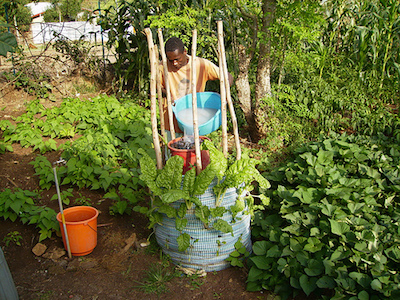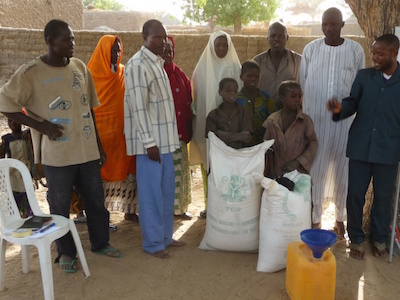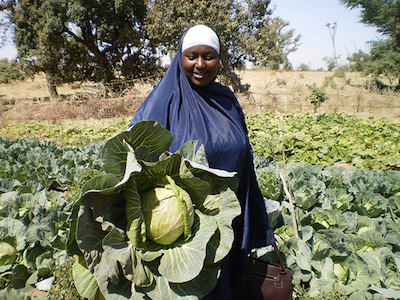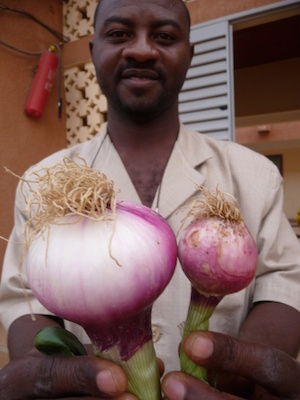Productive Sanitation & the Link to Food Security
Contents
[hide]- 1 Summary
- 2 Background
- 3 The historical link between sanitation and agriculture
- 4 Economic implications
- 5 The productive sanitation approach
- 6 Cities as hot spots for resource recovery
- 7 Resource recovery in rural areas
- 8 Institutional and legal aspects
- 9 Management of health risk
- 10 Business opportunities
- 11 Challenges and way forward
- 12 Acknowledgements
Summary
Productive sanitation is the term used for the variety of sanitation systems that make productive use of the nutrient, organic matter, water and energy content of human excreta and wastewater in agricultural production and aquaculture. These systems should enable the recovery of resources in household wastewater, minimise consumption and pollution of water resources, support the conservation of soil fertility as well as agricultural productivity and thereby contribute to food security and help to reduce malnutrition.
The implementation and scaling-up of productive sanitation systems is inhibited by weak, non-existing and sometimes prohibiting legislation. It is therefore necessary to develop relevant legislation along the sanitation chain taking into consideration the type of crops, occupational health, food hygiene and other preventive and risk management measures. This requires awareness raising, advocacy and behavioural change by all stakeholders. Further applied research is also needed to assess risk management options at the interface between agriculture and sanitation to support policy dialogue at the local and national level.
Background
Food security and the access to safe water and sanitation are fundamental human rights that for many people remain a promise unfulfilled. Globally still some estimated 2.6 billion people do not use improved sanitation facilities (WHO, UNICEF, 2010) and around 925 million worldwide are chronically undernourished (FAO, 2010). A great deal of the population growth will take place in urban areas leading to a substantial increase in urban food demand and a corresponding increase in the amount of organic waste, human excreta and wastewater from cities to be managed in a safe and productive way. The safe recycling of sanitation products can contribute to improved resource management, reduce environmental impact and improved health and nutrition.The resource perspective
Considering the number of people to be fed and the existing resource limitations, the food security issue should be approached with having resource preservation and recovery in mind. Here, productive sanitation systems play a key role. At present farmers worldwide use around 164 million tons of synthetic fertiliser in terms of N, P2O5 and K2O annually (IFA, 2011). The production of the most important and commonly used fertiliser ingredients i.e. nitrogen (N), phosphorus (P), and potassium (K) is energy-intensive. Furthermore, the mineable phosphorus and potassium reserves are finite. The crop yields today depend to a large extent on mined phosphate rock and potassium, a significant departure from historical food production methods (UNEP, 2011). One additional concern is that lower grade phosphorus which might increasingly be mined in the future is often contaminated with radioactive uranium.
Recent phosphorus fertiliser price increases and the uncertain phosphorus future, stress the need for resource recovery on a global level (Rosemarin, de Bruijne, Caldwell, 2009). It is estimated that the globally available phosphorus from urine and faeces could account for 22% of the total global phosphorus demand (Mihelcic, Fry, Shaw, 2011).
There is a triple driver for treated excreta use in agriculture in terms of nitrogen – to reduce fossil fuel use (from nitrogen extraction), reduce emissions of gases responsible for climate change and to reduce the input of reactive nitrogen in ecosystems.
Another essential resource in food production is water. Agriculture is a water intensive process and consumes 70% of the total water withdrawn globally (FAO, 2011). The supply and availability of water is increasingly diminishing and is unevenly distributed globally. Already today, large parts of Asia, Africa and the Middle East face either physical or economic water scarcity.
The disposal oriented sanitation systems together with continuous and excessive use of synthetic fertilisers on farmlands can lead to serious environmental consequences such as eutrophication of surface waters, dead zones along coastal estuaries and high nitrate concentrations in groundwater with a negative impact on human health.
Although in conventional agriculture the loss of the most important macronutrients is being compensated through application of synthetic fertilisers, these fertilisers cannot replace the loss of organic matter, microorganisms and many micronutrients equally important for fertile top soils. In many parts of the developing world the “mining” of soil nutrients is severe and crop yields are falling, as nutrients removed by the crops are often not replaced.
Health impacts of undernutrition
It is estimated that the underlying cause for around one third of all deaths of children under five years old is undernutrition. Children and adults who are suffering from diarrhoea and intestinal worm infections like ascaris, trichuris and hookworm obtain fewer calories from the food they eat (DFID, 2009) and (Humphrey, 2009). Productive sanitation could lead to higher crop yields, leading to less undernutrition and hence less susceptibility for disease, growth stunting in children and death. In addition, preventing diseases caused by lack of sanitation, such as diarrhoea and helminth infections, would lead to a more efficient use of available nutrients in food.
The historical link between sanitation and agriculture
Food production is historically linked with using liquid and solid waste from human settlements in agriculture. Only after the introduction of phosphorus mining in the mid 19th century, and industrial ammonia production at the beginning of the 20th century, it became the prevailing practice to replace nutrients with synthetic fertilisers. In the same era water based sanitation systems with flush toilets and sewers were installed as a response to the acute health crisis in large cities at that time. The idea that human excreta is a waste product without a useful purpose is a modern misconception: pits, water bodies and landfills are used nowadays as sinks for nutrients, organic matter and pathogens.
Economic implications
A high percentage of the population in areas affected by the sanitation crisis carry out subsistence farming (IAASTD, 2009) and struggle to maintain an income for feeding their families. Workdays and income won through improved water and sanitation services are thereby also a contribution to food security.Food and fertiliser prices have been particularly unstable since the beginning of 2008 (see Figure 2). When fertiliser prices rise, developing countries which are dependent on fertiliser imports for agricultural production are particularly vulnerable. Recycling of nutrients and organic matter from human and animal excreta, wastewater and organic waste can therefore make a big difference to local crop yields.
The average rural family of 9 in Niger excretes annually the nutrient equivalent of 100 kg (2 bags) of synthetic fertilisers (Dagerskog, 2009). The resource reuse in agriculture can boost yields considerably. Fertilising with urine can achieve comparable results to synthetic fertilisers (Gensch, Itchon, Miso, 2011). Within the poor population in developing countries an estimated 40-80% of all generated household income is used for food (Viljoen, 2005). Where there is space for gardens, productive use of sanitation products can reduce household expenditures for the purchase of food.The productive sanitation approach
Productive sanitation is a general term used for the variety of sanitation systems that make productive use of the nutrient, organic matter, water and energy content of human excreta and wastewater in agricultural production and aquaculture. These systems enable the recovery of nutrients and/or energy in household wastewater, minimise consumption and pollution of water resources and support the conservation of soil fertility as well as agricultural productivity and thereby contribute to food security. Productive sanitation systems can be considered sustainable if technical, institutional, environmental, social and economical aspects are appropriately addressed, according to the Vision Document of SuSanA.
Some technologies out of a great number of options for treating and using excreta and wastewater in a productive way include:
- Use of source-separated urine
- Struvite production
- Arborloo
- (Co-)Composting
- Short rotation plantations
- Biogas plants
For more information on each of the technologies please have a look at the factsheet.
Flow streams
Wastewater and human excreta consist of different streams. Due to their different characteristics, it can be advantageous to consider separate collection with adapted treatment processes and application methods according to the flow stream’s properties:
- Human urine contains essential plant nutrients like N, P, K and smaller fractions of micronutrients, in plant available form. Human urine, when leaving the body, is essentially pathogen-free.
- Human faeces are a valuable soil conditioner and can improve pH, nutrient content and water retention capacity of the soil and the ability of plants to withstand insects, parasite attacks and pests.
- Greywater is the wastewater from kitchen, baths and showers. After appropriate treatment or other risk reduction measures greywater can be safely reused for irrigation.
- Wastewater is a term used for all kinds of wastewater and storm water mixed together. Due to its high nutrient and water content it can also be used as a fertiliser and irrigation source. However, due to the high pathogen load in domestic wastewater, treatment and appropriate risk reduction measures should be applied before use in agricultural production.
- Organic solid waste consists of organic kitchen waste, leaves, grass etc. that accumulate in households. Organic waste can also be used for gardening after a treatment process such as composting.
Benefits of productive sanitation
- The efficient resource reuse minimises uncontrolled excreta discharge in surface and groundwater with less environmental degradation.
- The use of treated wastewater as irrigation water can lead to a more economical use of potable water.
- In terms of soil fertility the nutrient loss through the harvest is almost completely compensable with excreta-based fertilisers.
- The organic matter from human and animal excreta improves the water retention capacity of the soil reducing irrigation water requirements and the vulnerability to droughts. Moreover the organic matter balances the soil temperature and enhances the buffering capacity of the soil.
- It can reduce health costs due to a better nutritional status of the population and less exposure to pathogens.
Cities as hot spots for resource recovery
The current global urban population is expected to double by 2050 compared to 1990, with 90% of urban growth taking place in developing countries (Drechsel, Quansah, Penning, 1999). We need a transition to sustainable and resilient cities, which requires enhancing quality of life while minimising resource extraction, energy consumption, waste generation and safeguarding ecosystem services. This is directly related to city planning: to the development of city-based energy, waste, transportation, food, water and sanitation systems (Lüthi et al., 2011.
Urban and peri-urban agriculture (UPA) is the production of food and related services within and around cities. UPA includes urban horticulture, livestock, (agro-) forestry, aquaculture and related processing and marketing activities. Production of food by poor urban households can supply up to 20-60% of their total food consumption (De Zeeuw, Dubbeling, 2009). UPA also increases the availability of fresh, healthy and affordable food for a large number of urban consumers.
Decentralised safe reuse of wastewater and composted organic waste in UPA will help to:
- Adapt to drought by facilitating year-round production, making safe use of wastewater and nutrients in water and organic waste;
- Reduce the competition for fresh water between agriculture, domestic and industrial uses;
- Reduce the discharge of wastewater into rivers, canals and other surface water and thus diminish their pollution;
- Make productive use of the nutrients in wastewater and organic wastes.
UPA contributes to local economic development, poverty alleviation, social inclusion of the urban poor – women in particular – and to reduced vulnerability of cities and their inhabitants. Nutrient loops can be closed and the environmental benefits of urban agriculture can be enhanced.
Resource recovery in rural areas
| |
Almost 50% of the world population still live in rural areas, where local reuse can be relatively simple and make a big difference, especially for smallholder farmers. The resource potential of human excreta needs to be emphasised, and a close collaboration with the agriculture sector established.
Two recent productive sanitation projects in Burkina Faso and Niger were financed from the agricultural sector (EU food facility and IFAD), where treated urine and faeces have been termed “liquid and solid fertiliser”, and toilets and urinals are promoted as “fertiliser factories” (Dagerskog, Bonzi,2010). Agricultural extension workers were at the forefront of these projects, using farmer field schools to show the effect of treated urine and faeces as fertilisers.
This created demand for toilets and urinals that transformed dangerous raw excreta into safe fertilisers. There are examples of villagers selling and buying treated urine and faeces, as well as households in surrounding villages that construct toilets or urinals on their own initiative to obtain the safe fertiliser.
Institutional and legal aspects
Weak, non-existing or sometimes prohibiting legislation on reuse of excreta and wastewater makes it difficult to implement and scale up productive sanitation systems. Ideally, a regulatory framework should facilitate the safe reuse of resources from sanitation systems. Resource reuse may require changes to existing sanitation, environmental and agricultural policies, or the development of new policies. Effective laws and regulations establish both incentives for complying as well as sanctions for not complying with the requirements. It is necessary to develop relevant legislation along the sanitation chain, from excreta treatment and transport to application of fertiliser, restrictions on the type of crops grown, occupational health, food hygiene and other preventive measures. The “Guidelines for safe use of wastewater, excreta and greywater in agriculture and aquaculture” (WHO ,2006) can be used as a reference when national policies and legislation are developed. Allowing treated excreta as fertilisers and organic matter sources in organic and conventional agriculture would certainly boost recycling. The International Federation of Organic Agriculture Movements (IFOAM) restricts the use of human excreta on food crops, but exceptions may be made where detailed sanitation requirements are established by the standard setting organisation to prevent the transmission of pathogens (IFOAM, 2005). However, if the use of sanitised excreta in agriculture is prohibited in the food importing country, the exporting country will not use it except for own consumption. An example is the EU legislation on organic farming, which does not allow the use of sanitation products as fertilisers for organic crops to be sold in the EU (Richert et al., 2010).
Management of health risk
Sanitation related health risks occur mainly through persistent pathogenic organisms in excreta such as bacteria, viruses, protozoa and helminths. If not collected, treated, transported and applied properly this can lead to transmission of infectious diseases such as diarrhoea and the proliferation of intestinal worms. The purpose of every sanitation system is therefore to protect human health and install effective barriers against possible exposure to pathogens.In this context the WHO has set up guidelines to protect the health of individuals and communities regarding the productive use of excreta, greywater and wastewater and recommend a flexible multi-barrier approach for managing the health risks (WHO, 2006). Hormones and pharmaceutical residues do occur in wastewater and sludge as human beings excrete them with their urine and faeces. There is a theoretical possibility that if wastewater is reused in agriculture, but even more so in aquaculture, these micro-pollutants could enter the human food chain.
However, these risks are small in comparison to the dangers of pathogens and diarrhoea which are the main challenges when sanitation is lacking, but also in comparison to pharmaceutical residues contained in animal manure, or risks resulting from pesticide use. Soil is considered a more suitable medium for natural degradation of pharmaceuticals than water. Pharmaceuticals can be degraded better in aerobic, biologically active soil layers with a high concentration of microorganisms and longer retention times than in the more sensitive ecosystems of water bodies (Richert et al., 2010). Contamination of wastewater with heavy metals from industrial wastewater should be avoided through introduction of cleaner production approaches which keep industrial wastewater apart from domestic wastewater and imposing proper treatment processes within industries.
Business opportunities
The water, nutrients and energy recovered could enable cost reduction or recovery in the sanitation service chain and could offer market opportunities.
Increasingly there is agreement on the need to move from “treatment for disposal” to “treatment for reuse” (Drechsel et al., 2011). Successful involvement of the private sector in providing sanitation services and recovering resources in waste materials will directly enhance the livelihoods of millions of households in rural and peri-urban areas of developing countries.
In low-income countries, sanitation and waste management traditionally have been either neglected or subsidised by public-sector agencies, with service quality varying across locations and income levels resulting in notable health and environmental problems. This reliance on public-sector provision has prevented development of markets in sanitation services that might be best provided by private companies. The market analysis and business planning needed to promote private sector or public private activities has not been conducted, although interest in developing viable business models is increasing among donors and international organisations.
Challenges and way forward
Despite all known and convincing benefits of productive sanitation, a number of challenges and problems still need to be overcome which differ largely between countries and regions. These concern cultural barriers and perceptions, political will, missing knowledge on economics of waste management and reuse, development of appropriate regulations and legal frameworks, and technical aspects of making reuse profitable.
In most parts of the world, the productive sanitation concept has not been fully embedded in legislation. The cultural barriers, fear of health impacts, and the neglect of sanitation and wastewater management in general might explain the lack of clear policies in support of safe reuse options.
Reversing current trends and patterns requires the adoption of holistic and integrated approaches. Multi-stakeholder consultation, joint planning and decision-making will be needed to adapt existing policies or develop new ones. More applied research is also needed to assess risk management options in the agriculture and sanitation interface in support of policy dialogue at the local and national level.
Acknowledgements
SuSanA factsheet: Productive sanitation and the link to food security. April 2012. susana.org








